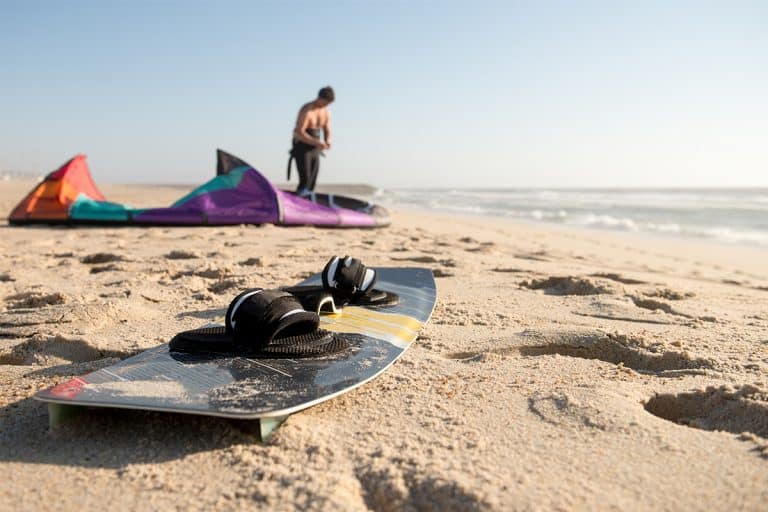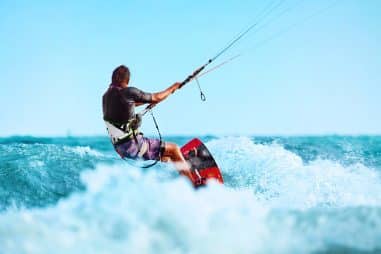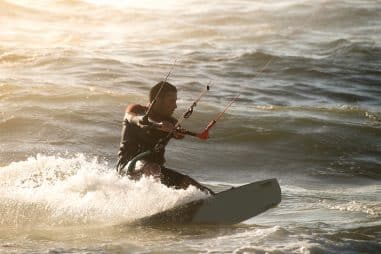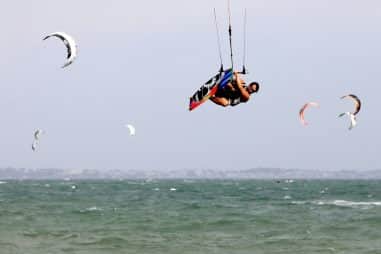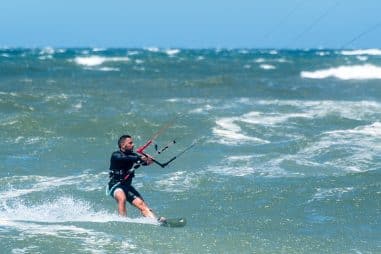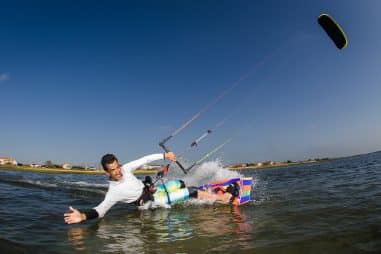Kiteboarding is slowly getting recognized by thrill-seekers all over the world. Although it can be a bit hard (on you and your wallet) to get started on the sport, it does prove to be fruitful as you learn and improve on this particular sport.
How Much Does It Cost to Start Kiteboarding?
Kiteboarding is far from being the cheapest sport. From lessons to instructors to gear, it can cost you upwards of 3,000 dollars.
The total varies on the lessons you’ll take and the equipment you’ll rent or buy but overall it can be a little hard on the wallet.
Why Is Kiteboarding So Expensive?
Kiteboarding is more expensive than your regular sport due to many different reasons. Read on to see a list of why kiteboarding can pretty much cost you an arm and a leg.
- Popularity: Compared to other sports, the community of kiteboarders in the world is fairly small. This means that the number of manufacturing companies for the equipment used in the sport is also relatively small and, often, these gears are not mass-produced. In fact, many gears are made more exclusively and are often customized to the kiteboarder.
- Gear: While other water sports only use one, two, or maybe three gear (for instance, you only need a surfboard to go surfing), kiteboarding asks for a lot more items. Other equipment may come in packages or they may be sold together, but some of the gear is being sold by piece which will collectively make a dent in your savings.
- Materials: Kites used for kiteboarding are not made with just any fabric. They are specifically made with strong yet lightweight material. The price goes up as the materials being used get stronger and lighter.
- Board: You might think that the board being used in kiteboarding is just like any other board, but you will be surprised to know that manufacturers put in the time and effort to be highly knowledgeable in hydrodynamics which is very important especially in the design stage. Before launching the boards, they go under several trial and error to make sure that everything is in place. Aside from that, the materials that are being used in these boards do not come cheap and they are also produced by manual labor from highly skilled professionals.
- Labor: Making the kites for kiteboarding are highly labor-intensive. They are not mass-produced in a plant neither are they produced in the sweatshop. Kites are often designed and made by professionals who understand the essence of kitesurfing. They are made with the highest level of quality that their make is often on par with that of parachute and paragliding products.
- Research and design: Manufacturers just don’t go and think of a design on top of their heads. Before they even come up with one design, a lot of time and effort are put into research and experiment to fully understand how aerodynamics will work on their design.
- Lessons: Aside from all of the above-mentioned reasons, another aspect that makes kiteboarding expensive is the lessons. It is not advisable to learn kiteboarding on your own because of its high-risk nature. You have to enroll in a kiteboarding school or take lessons from a highly qualified kiteboarding instructor to be able to learn the sport. They would either charge you per hour of lessons or give you a package price (if you are in a group). However, you can’t possibly learn the sport in just one hour which means that as long as they keep teaching, you have to keep paying.
What Do You Need for Kiteboarding?
To get into kiteboarding you must first get your hands on the complete basic kiteboarding equipment which include, but is not limited to:
- Kite
- Kiteboard
- Harness
- Spreader Bar
- Kite Control Bar
- Kite Lines
- Safety Release System
- Kite Pump
- Straps
The following items can be useful to your kiteboarding activity but it’s up to you if you want to get these items
- Anemometer
- Portable Toolbox
- Portable Survival Kit
- Sunscreen
- Surf Ear Plugs
- Ding Repair kit
- Wetsuit or rash guard
- Helmet
- Kite bag
- Leashes
- Surf Camera
- Impact Vest
How Do I Choose Kiteboarding Equipment?
While there are a lot of items listed above, your priority should be picking the right kiteboard and kite for you. These two gears are not made as a one-size-fits-all type of deal. Your friend’s board and kite might be the absolute perfect gear for them, but it might have the opposite effect on you.
The rule of thumb is to buy or rent a larger kiteboard paired with a smaller kite. Opt for a larger kiteboard because it will give you more space to be able to learn and be comfortable balancing and floating, and it is easier to get used to the center of gravity.
In some cases, if you will be learning the sport somewhere the wind is too low, it is recommended to get a larger kiteboard and kite no matter the skill level.
How Do You Buy Kiteboarding Gear?
While you will probably be taught using a beginner specific kit, it’s not advisable to purchase the same kit once you are done with the lessons. This may only be useful to you for the first few weeks, but you would eventually outgrow them sooner than later.
Professionals recommend that even if it is your first set up, you are better off buying a set of kite and board that can serve you from beginner to intermediate level. You don’t need a kite and board that would only stay with you for a couple of weeks. Find gears that would be useful to you even if you move up a skill level.
What Are the Best Kiteboarding Brands?
If you are on the lookout for your first kiteboarding kit or you want to upgrade, here are some of the top kiteboarding brands in the market today.
- Airush: Recipient of the 2018 Association of Wind and Water Sports Industries (AWSI) Brand of the Year Award, Airush is known for its high-quality kites including the widely acclaimed light wind Ultra 2 kite. Airush also has three different board constructions that cater to all skill levels, riding preferences, and riding style.
- Ben Wilson Surf (BWS): Owned by one of the best wave riders in the world, BWS is known for being the only brand whose gear is specially designed for wave riding. BWS has kites and surfboards that will allow you to ride any and all wave conditions.
- Cabrinha: Owned by the recognized surf sports pioneer, Cabrinha is one of the first kite manufacturers in the world and it has been in the industry for over 20 years. Cabrinha has been the choice of many water sports champions. From kites and bars to boards, foils, wings, and other gear, Cabrinha carries them all.
How Do I Choose a Kiteboard?
There are several different sizes of kiteboard to choose from and, generally, the rule of thumb is the bigger the better. However, it is not always the case for every kiteboarder especially if you are past being a beginner.
While bigger boards are recommended for beginners since it is easier to learn from, the bigger board may even be harder for you to manage especially in strong winds. Ultimately you have to choose a kiteboard that would support your progress from beginner to intermediate to advanced.
How Do I Choose a Twin Tip Kiteboard?
If you are looking for a new twin tip kiteboard as your board of choice, you must pay attention to these factors to be able to pick the best twin tip for you.
- Size: When choosing a twin tip kiteboard, size does If you own a bigger board, it would make standing up easier and it will also offer more stability in your riding and landing. However, one downside is that bigger boards tend to be bulkier and harder to manage and maneuver.
- Flex: The flex is focused on how flexible a kiteboard is. Boards with higher flex are better for your joints since they can absorb chops better compared to stiffer boards. Boards with more flex are recommended for beginners and they are also great for freeriding. Boards with medium flex are usually the go-to choice for intermediate kiteboarders because they offer both comfort and pop. Lastly, boards with stiffer boards are the usual choice of kiteboarders more into freestyle and wakestyle because they offer the most explosive pop.
- Rocker: Known as the curvature of the board, the rocker is another aspect to consider. Boards with lower or flatter rocker are better for beginners since it helps you get speed easier. On the other hand, intermediate kiteboarders opt for boards with higher rocker since it offers control even when riding with boots and stability in high-speed landings.
- Construction: It’s good to consider the materials used for the kiteboard as well. While boards are often made with a wood core, different layers of materials are often added to help make the board.
If you are a beginner, you will most likely learn how to kiteboard on a twin tip. One of the main characteristics of a twin tip kiteboard is that it is symmetrical which means that it can be ridden both ways and there is no designated front or back.
How Do I Know What Size Kiteboard to Buy?
Here are some aspects you should take into consideration if you are on the lookout for a new kiteboard.
- Your size and weight: Kiteboards are not made one-size-fits-all. Your body proportions are a few of the main things to consider when buying a kiteboard. People who are smaller and lighter should buy kiteboards within the 136 to 148-centimeter range while medium-sized people should choose those within the range of 145 to 160 centimeters. If you are a heavy rider, it is best to go with boards in the 150 to the 165-centimeter range.
- Wind strength: It is always best to know the average strength of the wind in your location of choice as this will tell you the best size of kiteboard to take. The rule of thumb is, if the location has lighter wind, it is best to get a bigger board, but if you are going somewhere with stronger winds, you should choose a smaller board since they are easier to manage.
- Riding style: Your preferred riding style also plays a role in choosing the best size kiteboard for you. If you are more the cruising type who likes to do simple carving turns and staying low altitude, you should choose a board within your size category (see: bullet point 1), but if you are into riding fast and flying high then you better choose a smaller board.
What Size Kiteboard Do I Need for My Weight?
If you are still having trouble choosing the right kiteboard for your size, here is a size chart to help you decide on what to buy.
|
Weight of Kiteboarder (in lbs) |
Weight of Kiteboarder (in kg) | Size of Kiteboard (in cm) | Width of Kiteboard (in cm) |
|
125 – 150 |
56 – 68 | 134 – 148 | 41 |
|
150 – 180 |
68 – 81 | 140 – 160 | 43 |
| 180 – 210 | 81 – 95 | 142 – 165 |
45 |
| More than 210 | More than 95 | 146 – 165 |
46 |
What Size Kiteboard Should I Get?
There is no simple answer to this question. Kiteboarders vary in size and weight, thus, a size that may be perfect for one, may not for another.
The first step is getting your body proportions correctly then you should also take into consideration the wind strength of your chosen location and your riding style before settling for a kiteboard.
If you are still having problems choosing the right size for you, it is always good to ask a professional instructor or a qualified sales representative to guide you.
How Much Does a Kiteboard Cost?
A kiteboard retails at around 400 to 1,000 dollars depending on the size, overall shape, and riding style. If you’re only going to try out the sport for a few hours, renting is the way to go because it will be less costly.
However, if you want to be serious with the sport, it is recommended to buy your own board whether brand new or secondhand as you would be using it all the time. Renting a board over longer periods of time will be more expensive in the long run.
How Do I Choose a Kiteboard Kite?
Although it is okay to look through kiteboarding forums to know other people’s kite preferences, what works for them may not work for you. There are several factors that you should consider when buying a kiteboard kite that would be perfect for you.
- Type: There are three types of kiteboard kite in the market nowadays namely C kite, Hybrid, and Bow.
- Bow kites: Recommended for beginners because they can be dully de-powered and re-launched in water. They are also best for larger wind ranges.
- Hybrid kites: Also referred to as Delta kites, this type is easier to manage for beginners than the last type, C kites. Hybrid kites have the best qualities of both the Bow kites and C kites.
- C kites: Best suitable for professional riders who are into doing unhooked tricks. While they have loads of pop and they are quick turning, C kites are more suitable in a much smaller wind range. Out of the three types, C kites are the hardest to re-launch in water.
- Size: Kites vary in many different sizes and, like the kiteboard, are not a one-size-fits-all situation. In choosing the size of your kite, you should also consider the strength of the wind in the location of your activity. Many pro kiteboarders recommend buying two kites, one that is suitable for light winds and the other should suitable for strong winds.
- Brand: In some cases, brands shouldn’t really be a big thing but in kiteboarding, it does pay to get gear from established brands. While you do pay less on off-brands, more established brands guarantee better construction and quality control, more refined bars, and improved safety systems. If you add these up with the years that you will be using the kite, it will be a lot less expensive compared to off-brand kites that will break on you on your first use.
What Size Kite Do I Need for Kiteboarding?
There are two factors that you should keep in mind when choosing the best kite size for you—your weight and wind speed in your chosen location.
Here is a size chart to understand this better.
| Weight of Kiteboarder (in kg) | 43 | 50 | 57 | 64 | 70 | 77 | 84 | 91 | 98 | 104 | 111 |
118 |
Wind Speed |
||
| Weight of Kiteboarder (in lbs) | 95 | 110 | 125 | 140 | 155 | 170 | 185 | 200 | 215 | 230 | 245 | 260 | knots | mph | mph |
| Size of Kiteboarding Kite (in m2) | 3 | 3 | 4 | 4 | 5 | 5 | 5 | 6 | 6 | 7 | 7 | 8 | 34 | 39 | 63 |
| 3 | 4 | 4 | 5 | 5 | 6 | 7 | 7 | 8 | 8 | 9 | 9 | 28 | 32 | 52 | |
| 4 | 5 | 5 | 6 | 6 | 7 | 8 | 8 | 9 | 8 | 10 | 11 | 24 | 38 | 44 | |
| 4 | 5 | 6 | 7 | 7 | 8 | 9 | 9 | 10 | 11 | 12 | 12 | 21 | 24 | 39 | |
| 5 | 6 | 7 | 7 | 8 | 9 | 10 | 11 | 11 | 12 | 13 | 14 | 19 | 22 | 35 | |
| 6 | 6 | 7 | 8 | 9 | 10 | 11 | 12 | 13 | 14 | 14 | 15 | 17 | 20 | 31 | |
| 6 | 7 | 8 | 9 | 10 | 11 | 12 | 13 | 14 | 15 | 16 | 17 | 15 | 17 | 28 | |
| 7 | 8 | 9 | 10 | 11 | 12 | 13 | 14 | 15 | 16 | 17 | 18 | 14 | 16 | 26 | |
| 7 | 8 | 10 | 11 | 12 | 13 | 14 | 15 | 16 | 18 | 19 | 20 | 13 | 15 | 24 | |
| 8 | 9 | 10 | 12 | 13 | 14 | 15 | 16 | 18 | 19 | 20 | 21 | 12 | 14 | 22 | |
| 8 | 10 | 11 | 12 | 14 | 15 | 16 | 18 | 19 | 20 | 22 | 23 | 11 | 13 | 20 | |
| 9 | 10 | 12 | 13 | 15 | 16 | 17 | 19 | 20 | 22 | 23 | 24 | 10 | 12 | 19 | |
How Long Do Kiteboarding Kites Last?
On average, per set of kiteboarding kites last 5 up to 7 years. Your kites may last longer or may last a lot less, it all depends on how much TLC you give them.
Even if you have been using your kite for a long time and it seems to be undamaged, keep in mind that it is not as strong as when you first bought it. Manufacturers recommend that if you are flying your kite about 50 times a year or more, it is best to discontinue use after 3 years.
What Do You Wear to Kiteboard?
While there is no particular set of rules on what (or what not to wear) when kiteboarding, it is best to wear something appropriate for the sport and something that would protect you from the sun, the wind, and the elements of the ocean.
Here are some options for your kiteboarding attires:
- Wetsuit: There are wetsuits specifically designed for kiteboarding that include special features that will help you while you are in the water. Kiteboarding wetsuits are usually made from neoprene because this material helps improve flexibility, especially when doing certain moves and maneuvers. There are even manufacturers that sell climate-appropriate wetsuits that are great for either winter or summer kiteboarding.
- Hoods, Gloves, and Booties: Since you will be in the water for long periods of time when kiteboarding, your extremities need protection as well. These items are also usually made from neoprene to combat the cold and to help avoid injuries from cuts. Aside from protection, gloves and booties also offer added grip on the kite and the board.
- Swimwear: If you are lucky enough to be kiteboarding in the tropics, you can forego the neoprene wetsuit and opt for the usual swimming attire such as swim shorts, a one-piece swimsuit, or a bikini.
- Board Shorts: Board shorts can be worn while kiteboarding but make sure that you choose the ones with the front ties because the usual snap fly or Velcro fly might not suffice. Board shorts are great because they are lightweight and non-restricting which allows you to move freely on the board.
How Much Does a Kiteboarding Setup Cost?
New and full kiteboarding set up may cost you around 1,000 to 3,000 dollars, sometimes even more than that, depending on the brand and the size of the gear.
The kiteboarding kite alone can retail at around 600 to 2,000 dollars which will surely put a dent in your kiteboarding budget. The kiteboard (with or without the straps) can cost you 200 to 1,000 dollars.
The spending doesn’t stop there as you still need to buy a control bar (ranging from 200 to 800 dollars), harness (100 to 400 dollars), and other items including proper kiteboarding attire, pump, and safety leash, and other kiteboarding gear that would ensure your improvement and safety.
You can choose to buy secondhand gear as they will be a lot cheaper, but you have to be smart about the ones that you will buy.
Make sure that the gear is not too old, especially kites, otherwise, you will have to deal with equipment with poor performance features which may be unsafe for you and the people around you.

